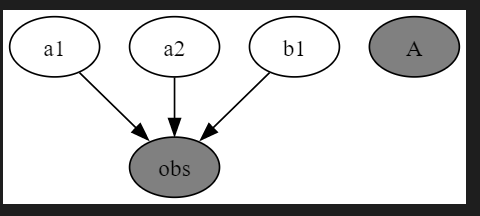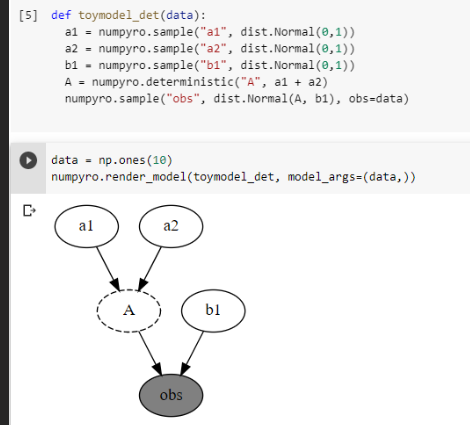I’m using pyro to build and render a model, but I think that deterministic relationships are not rendered correctly.
def toymodel_det(data):
a1 = pyro.sample("a1", dist.Normal(0, 1))
a2 = pyro.sample('a2',dist.Beta(0,5))
b1 = pyro.sample('b1',dist.Beta(0,5))
A = pyro.deterministic('A', a1+a2 )
pyro.sample("obs", dist.Normal(A, b1), obs=data)
data = torch.ones(10)
pyro.render_model(toymodel_det, model_args=(data,))
and this plots
Using numpyro, instead, and using the same model, it yields (screen of the code as well)
which is what I would expect.
Hi @NM_user , we haven’t implemented rendering deterministic sites yet in Pyro. Here’s the issue where we’re tracking work:
opened 02:54PM - 06 Sep 22 UTC
enhancement
help wanted
I would like to show variables explicitly using "render_model" that are function… s of other variables. I tried using "deterministic" or "Delta distribution" for this purpose, but this seems to not propagate like other distributions, e.g.
<pre>
def model(data):
m = pyro.sample("m", dist.Normal(0, 1))
sd = pyro.sample("sd", dist.Delta(m**2))
with pyro.plate("N", len(data)):
pyro.sample("obs", dist.Normal(m, sd), obs=data)
data = torch.ones(10)
pyro.render_model(model, model_args=(data,))
</pre>

If I define sd as a normal distribution it shows the connection between sd and obs correctly, but with "Delta" the connection is not shown. How can I define sd as a function of m that would show this connection?

